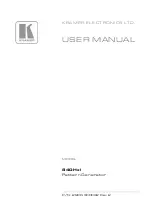
Owner’s Reference
DirectStream DAC MK2
©2022 PS Audio Inc. All rights reserved.
Introduction
®
PS Audio® Inc. 800-PSAUDIO 4865 Sterling Drive Boulder, Colorado 80301
recovery to keep to a given signal to noise ratio (S/N) with a slightly corrupted
digital signal.
•
Ironically, most sanely priced PCM players actually use DAC chips that utilize a
sigma-delta modulator (DSD) to get a DSD-like signal anyway. Similarly many
(most) A/Ds are sigma-delta based. The typical PCM path is analog -> DSD -> PCM
-> disc -> PCM -> DSD -> analog. The DSD path can skip the conversions to PCM.
Those conversions can’t be perfect and artifacts of the steep anti-aliasing filter or
the reconstruction filter aren’t considered benign by many.
•
DiectStreamMK2 handles the PCM conversion from AES/EBU, S/PDIF,
TOSLINK, I
2
S and USB without recovering a clock, by simply watching for
the edges and making decisions about what they mean in context. The result
is that any jitter present on the input is lost entirely in the FPGA. There is no
difference in TOSLINK or I
2
S because the output clock’s rate only depends on
the long term average rate of the inputs not on any edge or other local feature.
The heart of DirectStream MK2 is the DSD engine itself. Regardless of input format, whether
PCM or DSD, all data are upsampled to 30 bits running at 20 times the standard DSD rate and
then back down again to double rate DSD for noise shaping.
The internal volume control keeps complete precision: every bit in the input affects the
output of the DAC for any volume level. Except for the sigma-delta modulation process
itself there is no rounding, dither or other trimming, not to 24 bits, not to 32 bits, not to
48 bits, but rather a full 50. The incoming PCM signal is 30 bits from the upsampling filter
and the volume control is 20 bits wide so all 50 bits of the output are used throughout the
sigma-delta conversion, requiring more than 50 bits of precision.
DSD only requires a nominal 20 bit signal to noise ratio, this design utilizes a minimum
width of 24 bits with wide filter coefficients and 144dB S/N. Use of full precision
everywhere and many guard bits in the IIR filters and the sigma-delta modulator help
maintain our goal of perfecting the audio output.
While some designs may run out of headroom or approach saturation levels, depending
on the source material, the new design opts for an extra top bit everywhere in the digital
path coupled with an extra 6 dB of head room in the analog path beyond the 6 dB of
headroom that SACD uses. The top bit keeps PCM from saturating, even if that PCM was
not properly bandwidth limited in the initial recording process.
The output of the DSD engine is fed directly into the output stage, based on high speed video
amplifiers and a passive output transformer.
Most output schemes for DSD modulators are active low pass filters, covering the required
The DSD
engine is it's
heart
iv
Full headroom
with room to
spare







































